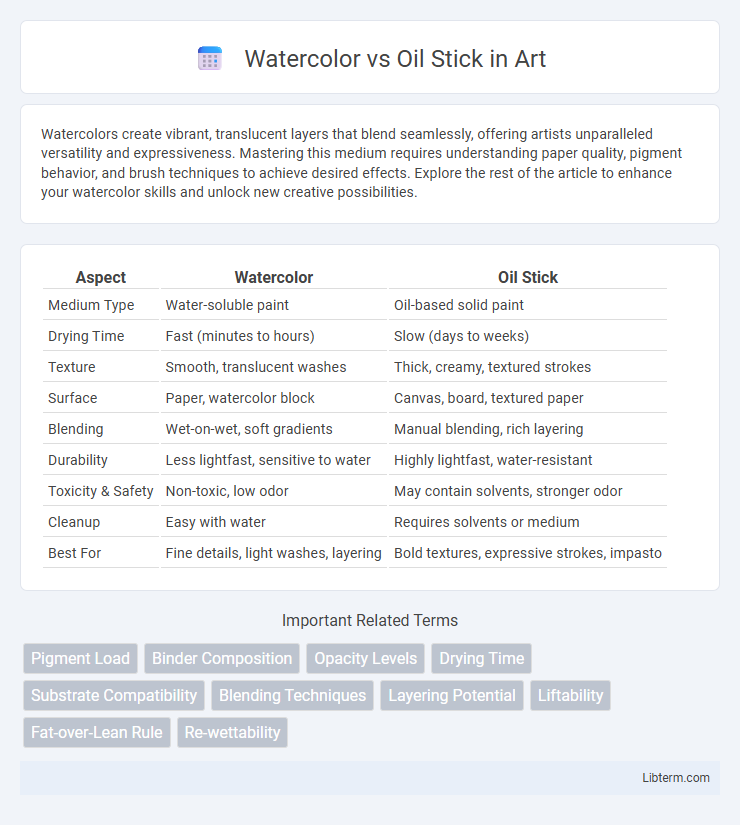Watercolors create vibrant, translucent layers that blend seamlessly, offering artists unparalleled versatility and expressiveness. Mastering this medium requires understanding paper quality, pigment behavior, and brush techniques to achieve desired effects. Explore the rest of the article to enhance your watercolor skills and unlock new creative possibilities.
Table of Comparison
| Aspect | Watercolor | Oil Stick |
|---|---|---|
| Medium Type | Water-soluble paint | Oil-based solid paint |
| Drying Time | Fast (minutes to hours) | Slow (days to weeks) |
| Texture | Smooth, translucent washes | Thick, creamy, textured strokes |
| Surface | Paper, watercolor block | Canvas, board, textured paper |
| Blending | Wet-on-wet, soft gradients | Manual blending, rich layering |
| Durability | Less lightfast, sensitive to water | Highly lightfast, water-resistant |
| Toxicity & Safety | Non-toxic, low odor | May contain solvents, stronger odor |
| Cleanup | Easy with water | Requires solvents or medium |
| Best For | Fine details, light washes, layering | Bold textures, expressive strokes, impasto |
Introduction to Watercolor and Oil Stick
Watercolor is a transparent painting medium composed of pigment mixed with water-soluble binders, offering delicate washes and fluid blending ideal for light-infused artwork. Oil sticks, also known as oil pastels or oil bars, consist of oil-based pigments in a solid stick form, delivering rich, textured strokes with vibrant, opaque color intensity. Both media provide unique expressive possibilities, with watercolor excelling in luminosity and subtle gradations, while oil sticks emphasize boldness and tactile surface effects.
Key Characteristics of Watercolor
Watercolor is characterized by its transparency and fluidity, allowing artists to create delicate washes and subtle gradients through water dilution. It dries quickly, making it ideal for layered effects and spontaneous adjustments, with pigments that often retain luminosity due to their light-reflective properties. Unlike oil sticks, watercolor requires paper or absorbent surfaces and offers a lighter, more ethereal finish suitable for detailed and atmospheric compositions.
Key Characteristics of Oil Stick
Oil sticks combine the rich, oily texture of traditional oil paints with the convenience of a crayon, providing intense pigmentation and smooth application. They dry slower than watercolors, allowing for extended blending and layering techniques that create depth and texture. Their ability to produce vibrant, opaque colors makes them ideal for bold, expressive artwork while maintaining the tactile, hands-on approach favored by many artists.
Surface and Paper Requirements
Watercolor requires absorbent, cold-pressed paper with a high cotton content to hold pigment and water effectively, preventing warping and ensuring vibrant color blending. Oil sticks demand primed surfaces such as canvas or smooth wood panels to support the thick, oily medium and prevent absorbency issues that can degrade the pigment's texture and longevity. Proper surface preparation is crucial in both mediums to achieve optimal adhesion, color saturation, and durability.
Color Vibrancy and Pigmentation
Watercolor offers translucent color vibrancy with a luminous quality due to its water-soluble pigments that allow light to reflect through layers. Oil sticks deliver intense pigmentation and rich, opaque colors because of their oil-bound pigments, providing a thick, textured application that retains brightness over time. Artists seeking bold, saturated tones often prefer oil sticks, while those valuing subtle color gradations and luminosity lean toward watercolor.
Application Techniques Compared
Watercolor application techniques emphasize layering transparent washes and controlled blending with water to create gradients and soft edges, enhancing luminosity and fluidity. In contrast, oil stick techniques involve direct, bold strokes with thick, opaque color, allowing for textural depth and impasto effects through scraping and layering. Mastery of watercolor requires delicate brush control and timing for wet-on-wet or wet-on-dry effects, whereas oil sticks demand pressure variation and manipulation of solid pigment consistency for dynamic, tactile surfaces.
Drying Time and Layering
Watercolor dries quickly, typically within minutes, allowing artists to apply multiple transparent layers rapidly for delicate washes and subtle gradients. Oil sticks have a much longer drying time, from several hours to days depending on thickness, enabling extensive blending and rich, textured layering without immediate drying. The slow drying process of oil sticks supports complex layering techniques, while watercolor's fast-drying nature suits vibrant, luminous effects with limited reworking.
Blending and Texture Creation
Watercolor offers fluid blending with transparent layers that create soft gradients and luminous textures ideal for delicate washes and subtle transitions. Oil sticks provide thick, opaque pigment application with rich, tactile textures, allowing artists to sculpt and blend directly on the surface for bold, expressive effects. The choice between watercolor and oil stick depends on desired texture intensity and blending control, with watercolor emphasizing smooth translucency and oil sticks delivering dense, textured depth.
Suitability for Various Subjects and Styles
Watercolor excels in creating delicate, translucent washes ideal for landscapes, botanical art, and subtle portraiture, offering smooth blending and light layering. Oil sticks provide rich, textured strokes suited for expressive, bold, and impasto techniques; they are favored in abstract, figurative, and contemporary art for their vibrant color density and tactile quality. Choosing between watercolor and oil sticks depends on the desired texture, drying time, and level of detail required for the subject and style.
Choosing Between Watercolor and Oil Stick
Choosing between watercolor and oil stick depends on the desired texture, drying time, and blending capabilities in your artwork. Watercolor offers transparency, quick drying, and fluid blending, making it ideal for delicate washes and detailed layering, whereas oil sticks provide rich, opaque colors with a buttery texture suitable for bold, textured strokes and longer manipulation. Consider the medium's interaction with paper or canvas, cleanup requirements, and the final visual impact when selecting between these two versatile art materials.
Watercolor Infographic

 libterm.com
libterm.com